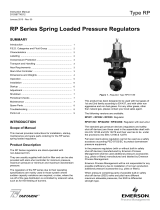
CS800 Series
10
If the slam-shut device trips due to a lever
disconnect failure of the main regulator, it is
recommended that you check downstream
equipment for damage prior to re-setting
the slam-shut.
Types CS805 and CS825 with
Secondary Seat™ Protection
CAUTION
Types CS805 and CS825 regulators do not
have any means to alert when the Secondary
Seat operates at lockup. Therefore, it
is recommended that Internal relief or
high-capacity relief are also selected or
the addition of some other method of
overpressure protection be added in the
downstream system as discussed in the
Overpressure Protection section.
Refer to Figure 6. The CS805 Series provides
Secondary Seat Protection. As downstream demand
decreases and downstream pressure rises to the regulator
pressure lock-up value, the regulator will lock up. If,
however, damage has occurred to the primary disk or
orice’s seating surface (seat) or debris has become lodged
between the primary disk and seat, the outlet pressure will
continue to rise. This additional pressure causes the disk to
apply additional force to the primary seat, which causes the
Secondary Seat to move toward the secondary disk/sealing
surface. If downstream demand decreases to zero, then the
Secondary Seat will contact the sealing surface to provide
lockup. Refer to Table 7 for approximate lock-up values
provided by the Secondary Seat.
Types CS806 and CS826 Secondary Seat
Protection with Bleed
When the Secondary Seat is providing lockup, the
CS806 Series provides small bleed to the downstream
system as an indication that the Secondary Seat is providing
lockup. In the event that the primary seat and disk cannot
provide lockup, the Secondary Seat will move into contact
with a metal disk with a small drilled hole. This metal-to-
metal interface and bleed hole will allow a small amount of
gas to bleed downstream thereby increasing outlet pressure
until the Internal relief valve begins to discharge gas to the
atmosphere. The odor of this discharged gas provides an
indication that the regulator is relying on the Secondary Seat for
overpressure protection. See Table 7 for the Downstream
Pressure Buildup of the Internal relief acting in conjunction
with the Type CS806 Secondary Seat Assembly.
Secondary Seat Protection Limitations
CAUTION
Overpresssure conditions can occur in the
downstream piping when the Secondary Seat
Protection is installed. The Secondary Seat
Protection serves only as a backup to the
primary seat for lockup. Refer to the sections
on Overpressure Protection and Maintenance.
Secondary Seat Protection does not provide additional
overpressure protection in the event the secondary seat or disk
is damaged by debris or contamination in the pipeline or from
conditions that would cause the regulator to go wide-open.
Installation and Overpressure Protection
WARNING
!
Personal injury or system damage may
result if this regulator is installed, without
appropriate overpressure protection, where
service conditions could exceed the limits
given on the regulator nameplate.
Regulator installations should be adequately
protected from physical damage.
All vents should be kept open to permit
free ow of gas to the atmosphere. Protect
openings against entrance of rain, snow,
insects or any other foreign material that
may plug the vent or vent line. For outdoor
installations, point the spring case vent
downward to allow condensate to drain
(see Figure 8). This minimizes the possibility
of freezing and of water or other foreign
materials entering the vent and interfering
with proper operation.
Under enclosed conditions or indoors,
escaping gas may accumulate and be
an explosion hazard. In these cases,
the vent should be piped away from the
regulator to the outdoors. See Vent Line
Installation section for the recommended
venting practices.
CAUTION
The CS800 Series regulators have an
outlet pressure rating lower than their inlet
pressure rating. If actual inlet pressure can
exceed the outlet pressure rating, outlet
overpressure protection is necessary.
However, overpressuring any portion of
the regulators beyond the limits in the
Specications section and referenced tables
may cause leakage, damage to regulator
parts or personal injury due to bursting of
pressure-containing parts.
Some type of external overpressure
protection should be provided if inlet
pressure will be high enough to damage
downstream equipment. Common methods
of external overpressure protection include
relief valves, monitoring regulators, shut-off
devices and series regulation.
























